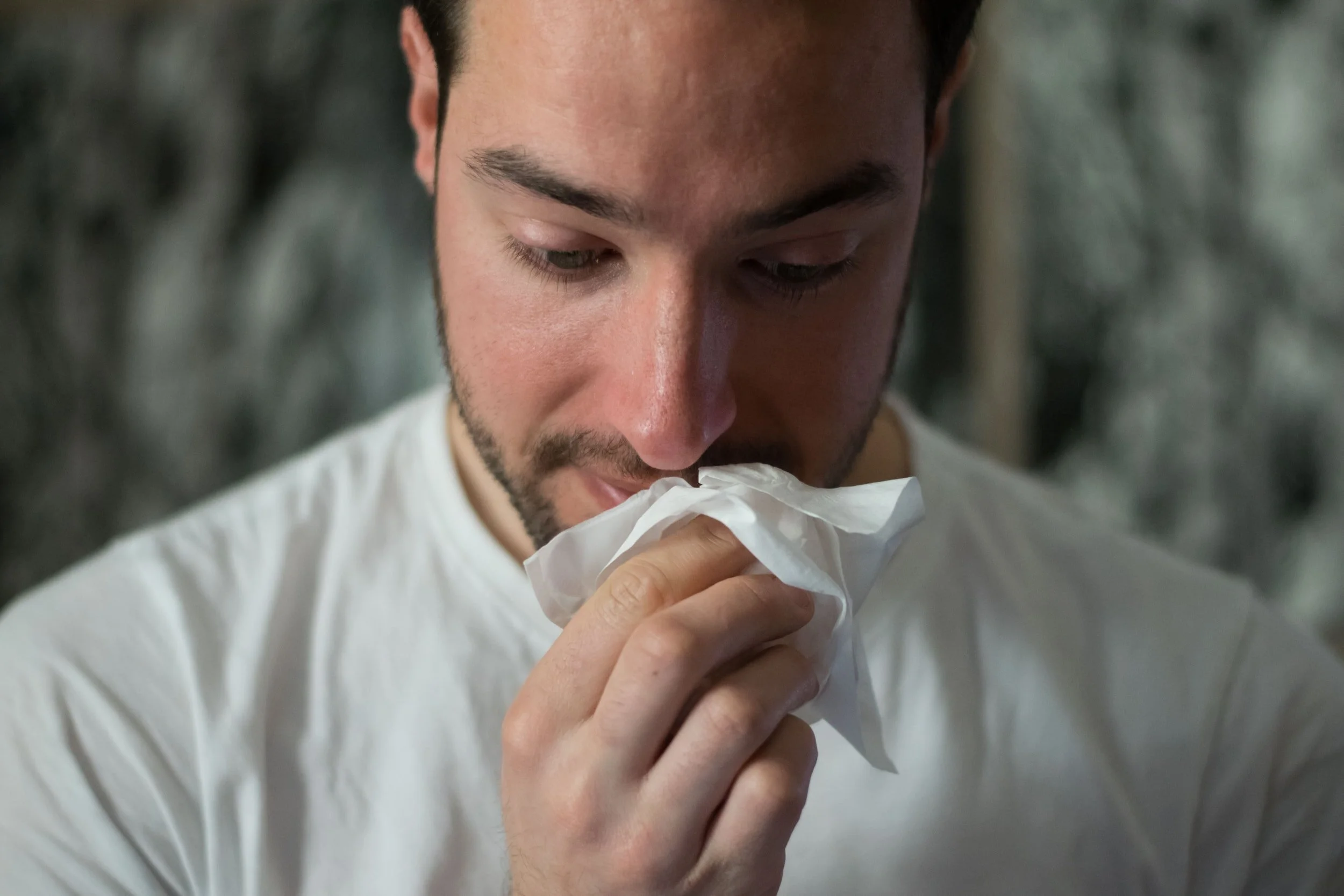Allergy, Infection, Irritation, Toxicity
Toxicity Molds can produce other secondary metabolites such as antibiotics and mycotoxins. Antibiotics are isolated from mold (and some bacterial) cultures and some of their bacteriotoxic or bacteriostatic properties are exploited medicinally to combat infections.
Mycotoxins are also products of secondary metabolism of molds. They are not essential to maintaining the life of the mold cell in a primary way (at least in a friendly world), such as obtaining energy or synthesizing structural components, informational molecules or enzymes. They are products whose function seems to be to give molds a competitive advantage over other mold species and bacteria. Mycotoxins are nearly all cytotoxic, disrupting various cellular structures such as membranes, and interfering with vital cellular processes such as protein, RNA and DNA synthesis. Of course they are also toxic to the cells of higher plants and animals, including humans. Mycotoxins vary in specificity and potency for their target cells, cell structures or cell processes by species and strain of the mold that produces them. Higher organisms are not specifically targeted by mycotoxins, but seem to be caught in the crossfire of the biochemical warfare among mold species and molds and bacteria vying for the same ecological niche.
Mycotoxin Effects – The class of small fungal secondary metabolites which has been given the name “mycotoxins” is definitely known to include many compounds which are highly toxic to vertebrates (such as humans). Most of the well characterized toxic effects are from animal feeding situations, either natural mycotoxicosis outbreaks caused by contaminated animal feed, or laboratory experiments based on feeding (or connected artificial experimental situations such as parenteral injection of purified toxins into experimental animals). Ingestion of mycotoxin-contaminated foods by humans results in similar symptoms. Toxic effects have also been found in laboratory experiments in which animals are exposed to mycotoxins via the respiratory tract. In cases involving humans and airborne exposure, the most suggestive of a direct mycotoxin effect are those in which heavily mold-exposed workers develop severe symptoms reminiscent of animal mycotoxicoses or contaminated-food mycotoxicoses.
As another example, classic stachybotryotoxicosis, described mostly from agricultural workers who handled or disturbed large quantities of material (usually hay or straw) contaminated by Stachybotrys chartarum, was characterized by “cough, rhinitis, burning sensation in the mouth, (throat) and nasal passages, and cutaneous irritation at (points) of toxin contact” (2). Nosebleeds were also common, and tracheal bleeding was occasionally reported. Whether such mycotoxin effects explain the symptoms seen in common building exposures has been disputed. It has been pointed out that, although the mycotoxins are often associated with disseminating fungal conidia, the quantities present may not be sufficient to explain the effects observed (3), at least not in terms of classic toxicosis. A number of mycotoxins or conidia of mycotoxigenic fungi, however, have also been shown to have effects such as activation of pulmonary alveolar macrophages (PAMs), DNA fragmentation in PAMs, inhibition of the oxidative burst killing mechanism in PAMs, and slowing of respiratory ciliary beat (e.g., 4). Such interactions with immune mechanisms may explain some symptoms not explained by toxicosis. Careful study of occupants of contaminated buildings suggests an association between inhalation of toxigenic fungi and nonspecific respiratory symptoms (5)
Moldy Odors are released from actively growing fungi may also pose a health risk. Not all molds produce mycotoxins, but numerous species do (including some found indoors in contaminated buildings). Toxigenic molds vary in their mycotoxin production depending on the substrate on which they grow (Jarvis, 1990). The spores, with which the toxins are primarily associated, are cast off in blooms that vary with the mold’s diurnal, seasonal and life cycle stage (Burge, 1990; Yang, 1995). The presence of competitive organisms may play a role, as some molds grown in monoculture in the laboratory lose their toxic potency (Jarvis, 1995). Until relatively recently, mold poisons were regarded with concern primarily as contaminants in foods. More recently concern has arisen over exposure to multiple mycotoxins from a mixture of mold spores growing in wet indoor environments. Health effects from exposures to such mixtures can differ from those related to single mycotoxins in controlled laboratory exposures. Indoor exposures to toxigenic molds resemble field exposures of animals more closely than they do controlled experimental laboratory exposures. Animals in controlled laboratory exposures are healthy, of the same age, raised under optimum conditions, and have only the challenge of known doses of a single toxic agent via a single exposure route. In contrast, animals in field exposures are of mixed ages, and states of health, may be living in less than optimum environmental and nutritional conditions, and are exposed to a mixture of toxic agents by multiple exposure routes. Exposures to individual toxins maybe much lower than those required to elicit an adverse reaction in a small controlled exposure group of ten animals per dose group. The effects from exposure may therefore not fit neatly into the description given for any single toxin, or the effects from a particular species, of mold.
Few toxicological experiments involving mycotoxins have been performed using inhalation, the most probable route for indoor exposures. Defenses of there respiratory system differ from those for ingestion (the route for most mycotoxin experiments). Experimental evidence suggests the respiratory route to produce more severe responses than the digestive route (Cresia et al.,1987). Effects from low level or chronic low level exposures, or ingestion exposures to mixtures of mycotoxins, have generally not been studied, and are unknown. Effects from high level, acute sub-acute and sub-chronic ingestion exposures to single mycotoxins have been studied for many of the mycotoxins isolated. Other mycotoxins have only information on cytotoxicity or in vitro effects.
Effects of multiple exposures to mixtures of mycotoxins in air, plus other toxic air pollutants present in all air breathed indoors, are not known. Effects of other biologically active molecules, having allergic or irritant effects, concomitantly acting with mycotoxins, are not known.
Measurement of mold spores and fragments varies, depending on instrumentation and methodology used. Comparison of results from different investigators is rarely, if ever, possible with current state of the art. While many mycotoxins can be measured in environmental samples, it is not yet possible to measure mycotoxins in human or animal tissues. For this reason exposure measurements rely on circumstantial evidence such as presence of contamination in the patient’s environment, detection of spores in air, combined with symptomology in keeping with known experiment allesions caused by mycotoxins, to establish an association with illness.
Response of individuals exposed indoors to complex aerosols varies depending on their age, gender, state of health, and genetic make-up, as well as degree of exposure. Microbial contamination in buildings can vary greatly, depending on location of growing organisms, and exposure pathways. Presence in a building alone does not constitute exposure.
Investigations of patients’ environments generally occur after patients have become ill, and do not necessarily reflect the exposure conditions that occurred during development of the illness. All cases of inhalation exposure to toxic agents suffer from this deficit. However exposures to chemicals not generated biologically can sometimes be re-created, unlike those with active microbial growth. Indoor environments are dynamic eco systems that change over time as moisture, temperature, food sources and the presence of other growing microorganisms change. Toxin production particularly changes with age of cultures, stage of sporulation, availability of nutrients, moisture, and the presence of competing organisms. After-the-fact measurements of environmental conditions will always reflect only an estimate of exposure conditions at the time of onset of illness. However, presence of toxigenic organisms, and their toxic products, are indicators of putative exposure, which together with knowledge of lesions and effects produced by toxins found, can establish association.
Field exposures of animals to molds (in contrast to controlled laboratory exposures) show effects on the immune system as the lowest observed adverse effect. Such immune effects are manifested in animals as increased susceptibility to infectious diseases. It is important to note that almost all mycotoxins have an immune suppressive effect, although the exact target within the immune system may differ. Many are also cytotoxic, so that they have route of entry effects that may be damaging to the gut, the skin or the lung. Such cytotoxicity may affect the physical defense mechanisms of there respiratory tract, decreasing the ability of the airways to clear particulate contaminants (including bacteria or viruses), or damage alveolarmacrophages, thus preventing clearance of contaminants from the deeper lung. The combined result of these activities is to increase the susceptibility of the exposed person to infectious disease, and to reduce his defense against other contaminants. They may also increase susceptibility to cancer (Jakabet al., 1994).
Because indoor samples are usually comprised of a mixture of molds and their spores, it has been suggested that a general test for cytotoxicity be applied to a total indoor sample to assess the potential for hazard as a rough assessment (Gareis, 1995).
Animal experiments in which rats and mice were exposed intranasally and intratracheally to toxic strains of S. chartarum, demonstrated acute pulmonary hemorrhage (Nikkulin et al. 1996). A number of case studies have been more recently published. One involving an infant with pulmonary hemorrhage in Kansas, reported significantly elevated spore counts of Aspergillus/Penicillium in the patient’s bedroom and in the attic of the home. Stachybotrys spores were also found in the air of the bedroom, and the source of the spores tested highly toxigenic. (Flappan et al., 1999). In another case study in Houston, Stachybotrys was isolated from bronchopulmonary lavage fluid of a child with pulmonary hemorrhage. (Elidemir et al., 1999), as well as recovered from his water damaged-home. The patient recovered upon removal and stayed well after return to a cleaned home. Another case study reported pulmonary hemorrhage in an infant during induction of general anesthesia. The infant was found to have been exposed to S. chartarum prior to the anesthetic procedure (Tripi et al., 2000). Still another case describes pulmonary hemorrhage in an infant whose home contained toxigenic species of Penicillium and Trichoderma (a mold producing trichothecene poisons similar to the ones produced by S. chartarum) as well as tobacco smoke (Novotny and Dixit, 2000) Toxicologically, S. chartarum can produce extremely potent trichothecene poisons, as evidenced by one-time lethal doses in mice (LD50) as low as 1.0 to 7.0 mg/kg, depending on the toxin and the exposure route. Depression of immune response, and hemorrhage in target organs are characteristic for animals exposed experimentally and in field exposures (Ueno, 1980; Jakab etal., 1994).
While there are insufficient studies to establish cause and effect relationships between Stachybotrys exposure indoors and illness, including acute pulmonary bleeding in infants, toxic endpoints and potency for this mold are well described. What is less clear, and has been difficult to establish, is whether exposures indoors are of sufficient magnitude to elicit illness resulting from toxic exposure.

